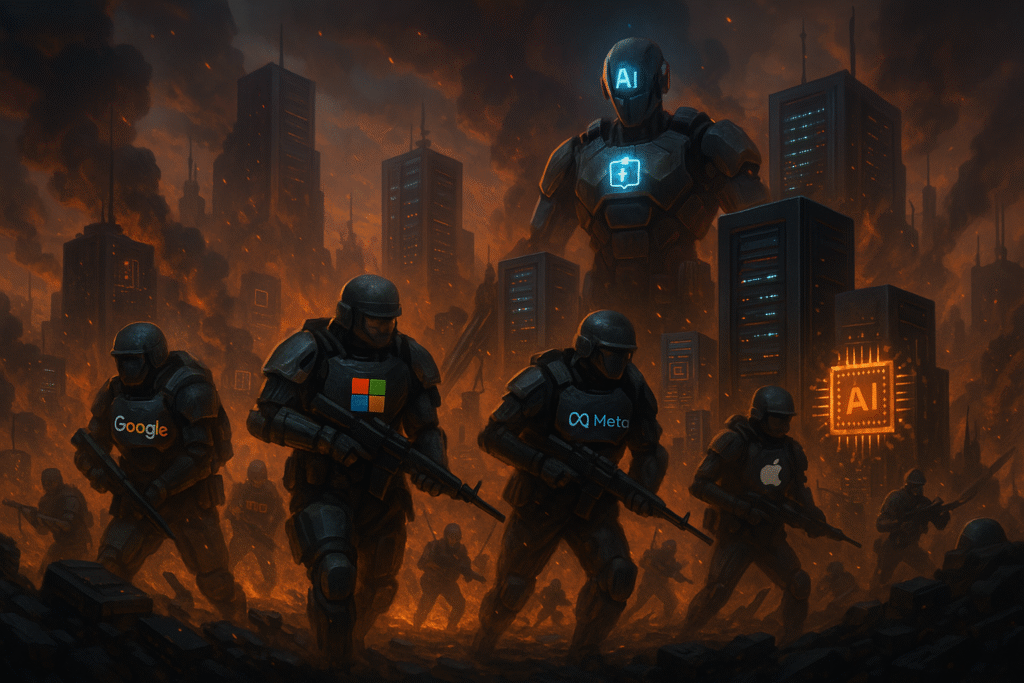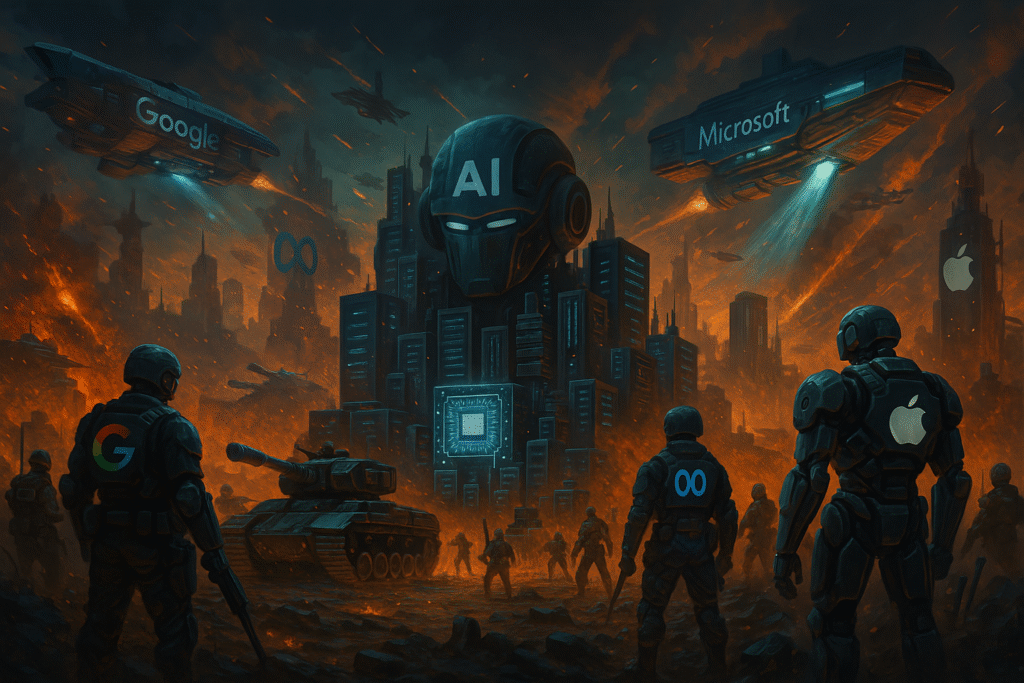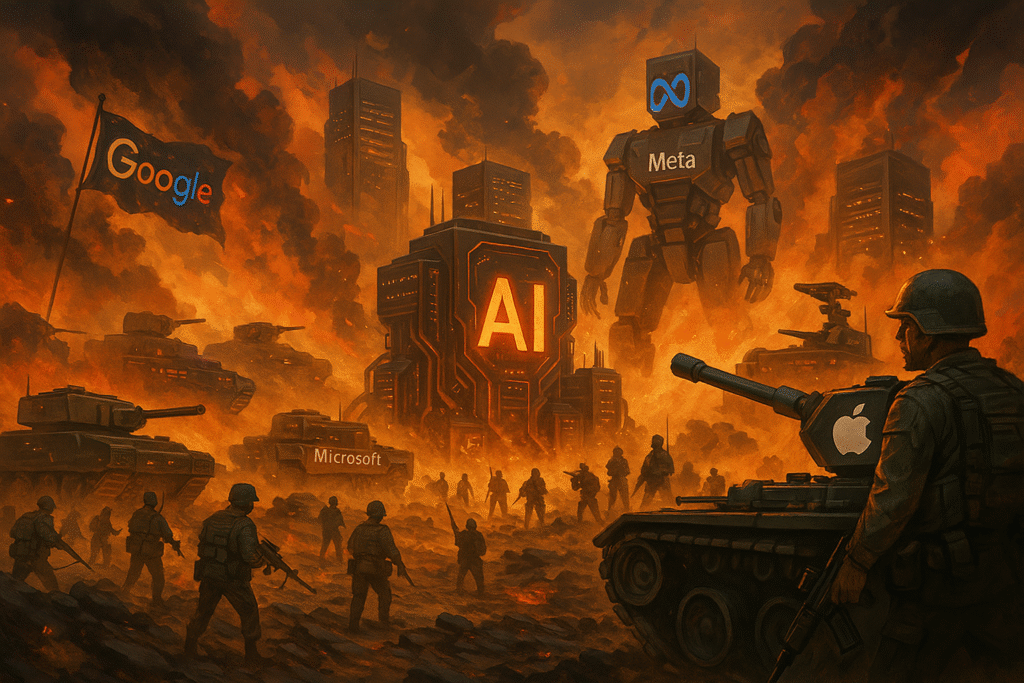AI Arms Race Introduction: The New Industrial Revolution is a War of Platforms
The AI Arms Race: History tells us that the winners of any industrial revolution are always determined not only by the inventors of a given technology, but by the builders and controllers of the core platforms that the new economy rests upon. The railways replaced the steam engine; those who made automotive production lines eclipsed the internal combustion engine; the personal computer and the internet stole a march on the potential of the microchip.
It’s 2025, and we are amidst another great technological revolution — not the digital revolution of the twentieth century, but the artificial intelligence revolution which is shaking the technology industry to its core and triggering a battle of the platforms unprecedented in size and stakes between the giants of the global tech industry.
This is not just a contest to see who has the smartest chatbot or the most whimsical image generator, it’s a foundational, multipronged, decades long war for the heart of future A.I.-powered ages, and even for the future of how we come to understand what those ages will look like.
Certain “hyperscalers”—predominantly Microsoft (in a deep symbiosis with OpenAI), Google (now united under the Gemini brand), Meta (proudly going its open-source way) and a strategically repositioned Apple—no longer are purely corporate moves on a board. Their tens of billions invested in large language models (LLMs), custom silicon, and cloud infrastructure are seismic shifts sending shockwaves throughout the global economy.
The AI arms race marks the beginning of a new industrial era where control over intelligence platforms is redefining global power. It’s not just tech—it’s economic supremacy.

II. The Fronts: The Four GoRunt Theatres of the AI Arms Race
The AI arms race is not a single conflict but a multi-front war, where establishing dominance in one theatre also yields an advantage in the others.
The AI arms race spans multiple competitive fronts, with Big Tech waging battles across models, cloud infrastructure, integration, and silicon. Each front influences the others.
Seed Models (The “Cognitive Core”)
This is the winning the largest, most capable, most efficient Large Language and Multi-Modal Models race. These models — Google’s Gemini family, OpenAI’s GPT series, Anthropic’s Claude and Meta’s open source Llama series — are the “cognitive core” of the revolution.
Dominance here is gauged in terms of counts of parameters, scale of training data, and, increasingly, efficiency and reasoning capacity of models. A top foundational model becomes the benchmark of possibility, drawing the best developers and the most ambitious enterprise clients. The R&D spend in this space is astronomical and it will continue to be a battle for a few players.
In the AI arms race, winning the seed model race means controlling the intelligence layer of tomorrow’s economy. The fight for the cognitive core is where power begins.
Cloud Infrastructure (The “Engine Room”)
AI is hungry on computation. Training a frontier model requires more electricity than a small city. That makes the cloud the imperative “engine room” of the AI revolution. The competition among the three leading cloud computing suppliers, Microsoft Azure, Google Cloud and Amazon Web Services (AWS), has escalated into a race to be seen to be the best “AI utility company”.
They are not just in a raw compute horsepower race, but a race to offer the most polished, developer-friendly platform to train and deploy AI models at scale. This is a theater shaped by massive capex’s in new data center’s and a fundamental pivot towards becoming builders of vertically integrated HW stacks.
Behind the scenes of the AI arms race is a cloud power battle—those who dominate compute power, dominate AI. It’s where silicon meets scale.

Distribution and Integration (The “Delivery System”)
An effective AI model is a stranded asset if it is not able to touch users. This front is the challenge of integrating AI capabilities into the digital surfaces upon which billions of people submit pictures and file videos and voice recordings and text messages and searchable records of their movements and communications.
It’s also a war of attrition waged on search engines (Google Search Generative Experience versus Microsoft Bing Chat), productivity suites (Microsoft 365 Copilot vs. Google Workspace with Duet AI and Associative Recommendations) and operating systems (Microsoft Windows Copilot vs. Apple’s forthcoming on-device intelligence).
The winner here will be the company that can make AI not just powerful, but invisibly useful, embedding it so deeply into workflows that it becomes indispensable.
The AI arms race isn’t just about building smart tools—it’s about embedding them into everyday life. Whoever owns user interaction, wins adoption.
Custom Silicon (The “Strategic Ammunition”)
The AI industry has been largely at the mercy of a single company for the last handful of years with respect to its “ammunition” – NVIDIA. This reliance on NVDA’s GPUs for training and inference has led to a huge strategic bottleneck and immense over-concentration of risk (and profits). And in a counter-push, all major players are now in deep development for their own custom AI accelerator chips.
Google’s Tensor Processing Units (TPUs) are the most mature, but both Microsoft’s Maia and Amazon’s Trainium/Inferentia chips are being pushed out quickly. The vertical integration is a strategic imperative to cost control as well as performance tuning to their product lines and insulate them from market and geopolitical volatility.
Custom chips are the new weapons in the AI arms race. To escape reliance on NVIDIA, tech giants are racing to arm themselves with homegrown silicon.
III. The Tech Titans’ New Postures in 2025
Every player has its own pool of resources, and its own strategic playbook that tells it how to fight the war.
Each Big Tech giant has chosen a unique battle posture in the AI arms race. Strategy, speed, and scale define their future dominance.
Microsoft / OpenAI: The First Mover’s Blitzkrieg
Strategy: Combative Merging and Corporate Domination. Beta Microsoft’s multibillion-dollar bet on OpenAI is a masterstroke, leapfrogging the competition on AI and cloud while bringing shifting the narrative about Microsoft’s strategic direction. Its dogma is that of quick, broad integration.
The aim is to integrate AI in every part of its sprawling enterprise and consumer product empire. Microsoft 365 Copilot is point of the spear, hoping to redefine the nature of workplace productivity by bringing in AI as an inseparable paid feature within Word, Excel, Teams and Outlook.
On the infrastructure side, Azure AI is the world’s enterprise destination for creating custom AI applications that leverage the capabilities of OpenAI’s powerful and trusted models.
Strength: Blindingly fast to market, and a very deeply entrenched (a.k.a. “sticky”) enterprise customer base that acts as a huge, built-in distribution channel. They have indeed managed to make AI a function that is a “must-have” in the discussion of enterprise software.
Weakness: There’s a complex and possibly brittle dependency on a key partner. And though it’s synergistic, the OpenAI affiliation brings dependencies and governance that Microsoft does not entirely manage, which could result in strategic tension down the road.
Microsoft and OpenAI’s aggressive tactics have made them first responders in the AI arms race, setting the pace for enterprise AI deployment.

Google: The Sleeping Giant’s Coordinated Counter-Attack
Strategy: Unification and Technical Supremacy. Blindsided by the launch of ChatGPT, Google over the course of the past two years has engaged in a massive internal reorganization in an effort to break up silos and unite its formidable (and often disparate) AI research divisions (Google Brain and DeepMind). The product is the Gemini range of models, with native multi-modality and technical superiority from the beginning.
Google’s plan is to use its unmatched cache of proprietary data (including data from Search, YouTube, Android and Maps) and its research talent from other disciplines to prevail on brute capability. It has one killer app: the ability to plug better models directly into its user base of billions.
Strengths: Decades of foundational AI research, huge and unique datasets to train on, complete control (end-to-end) over its custom silicon (TPUs), and the largest distribution channels in the world.
Weakness: A historically conservative and consensus-driven corporate culture that has occasionally struggled to commercialize its pioneering research as quickly and nimbly as its competitors. There’s a lot of pressure to try to work AI into Search without messing up the huge multi-billion dollar advertising that fuels the machine.
Google’s data empire and unified AI research give it a massive advantage in the AI arms race, if it can execute quickly and cohesively.
Meta: The Open-Source Insurgent
Strategy: Democratization and Disruption. Meta has a strategy, based on a different set of business imperatives, of playing the fierce insurgent. With the decision to open-source its beastly Llama series of models, Meta essentially is looking to commoditize the base model layer of the AI stack.
It is intended to prevent any single closed-source competitor (e.g. Google or OpenAI/Microsoft) from creating a toll-booth monopoly on powerful AI. Meta has by giving away the “blueprints” nurtured a system of developers across the globe who can build upon, improve and deploy its technology, speeding up innovation and making it hard for competitors to charge a premium just on model access.
Strength: Building a huge, loose, loyal ecosystem around its models. This is a strategy of choking off its rivals’ air supply and casting Meta as a patron and protector of the open-source world, which has a way of drawing great talent.
Weakness: Less clear and direct ability to monetize the foundational models themselves. The theory here is that the indirect benefit of making sure the next generation of AI-powered social apps (which Meta can build) aren’t built on a rival closed platform.
Meta’s open-source strategy flips the script in the AI arms race, weakening closed models by flooding the field with alternatives.

Apple: The On-Device Privacy Advocate
Strategy: Privacy-First, On-Device Intelligence. Apple has, also typically, kept its mouth shut and taken its time, but has been pouring huge, concentrated investments. Its approach is not to play the “who has the biggest model” cloud-based arms race. Instead, Apple is focusing on building really efficient, powerful models that can run largely on-device — on the iPhone, iPad and Mac.
This also feeds directly into Apple’s core brand and strategic advantages: user privacy (by keeping data off the cloud), tight integration of hardware and software and a focus on user experience rather than raw specs. There’s no aim to turn the OS into an omniscient chatbot, but to have AI functions feed into the OS that feel natural and can be helpful, and crucially are totally private.
Strength: A rock solid status quo of consumer trust over its privacy stance, full control from the hardware (custom silicon) to the software stack, and a high spending and loyal customer base.
Weakness: Later to the discussion around generative AI, with a less established history building and deploying cloud-based AI services at large scale than its rivals.
Apple is fighting a quieter, privacy-first battle in the AI arms race, banking on on-device intelligence to preserve trust and control.
V. Economic Consequences and The Way Forward
The result of this AI arms race will reshape the economic landscape for the next generation. AI “copilots” are already making knowledge work dramatically more productive, a trend that will accelerate. The cloud computing market is being entirely transformed by AI workloads, which are the single most important driver of growth and market share.
As the hyperscalers fight for control of the platform, a rich new ecosystem of “AI-native” startups is forming to build vertical applications that sit on top of these platforms, spawning completely new industries while it rewrites the old.
The velocity of innovation alone is absolutely daunting. What we are seeing is a sped-up and accelerated version of earlier platform shifts, one in which the strategic time horizons are counted in months, not years.
Those companies that can successfully negotiate this tangled, multi-front war will not only dominate technology, but they will also control the crucial infrastructure of the ideological battleground of the 21st century world economy. The clock is ticking, and the world that emerges on the other side will be radically, and irreversibly, different.
The AI arms race is more than a tech trend—it’s an economic reshaping force. Every sector it touches is being redefined, rebuilt, or replaced.
✅ External Links
MIT Technology Review – How Big Tech Is Racing for AI Dominance
World Economic Forum – How AI Is Reshaping Global Industry
✅ Internal Links
Best LLC Formation Service for 2025: Incfile vs. ZenBusiness vs. LegalZoom